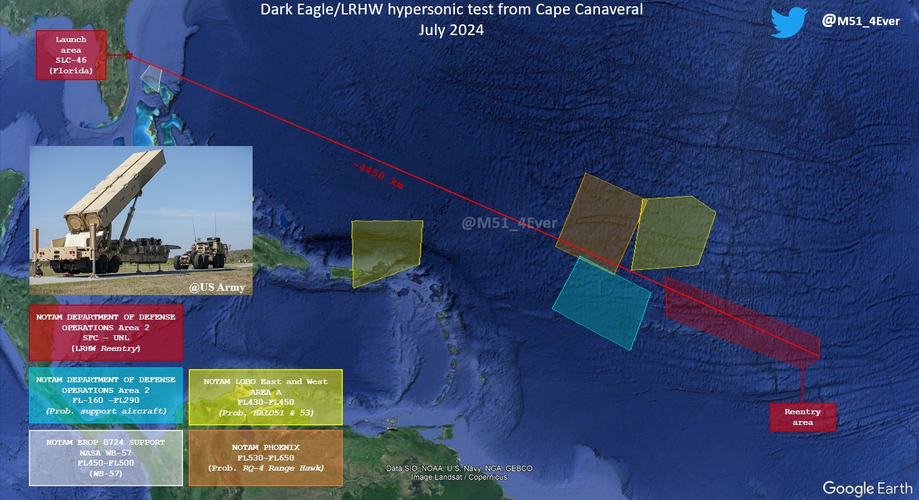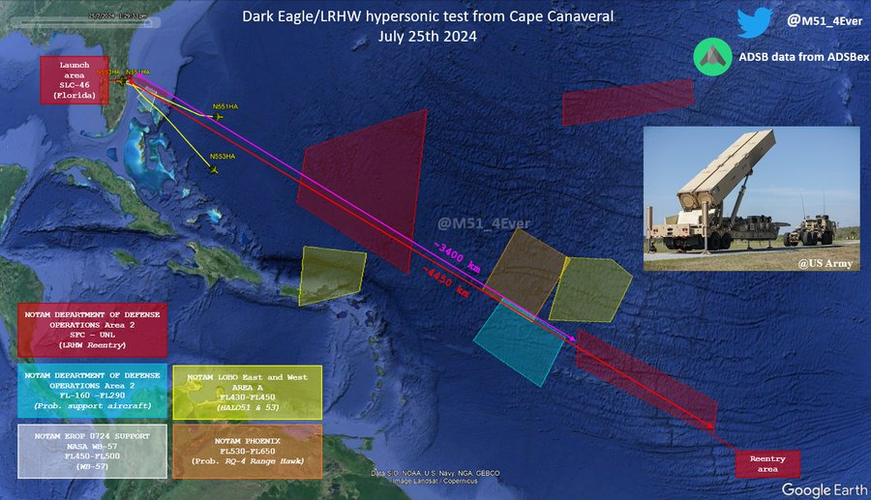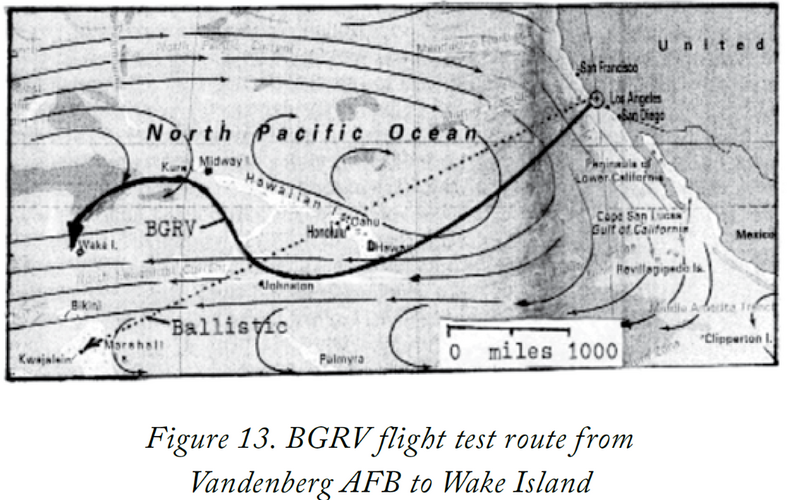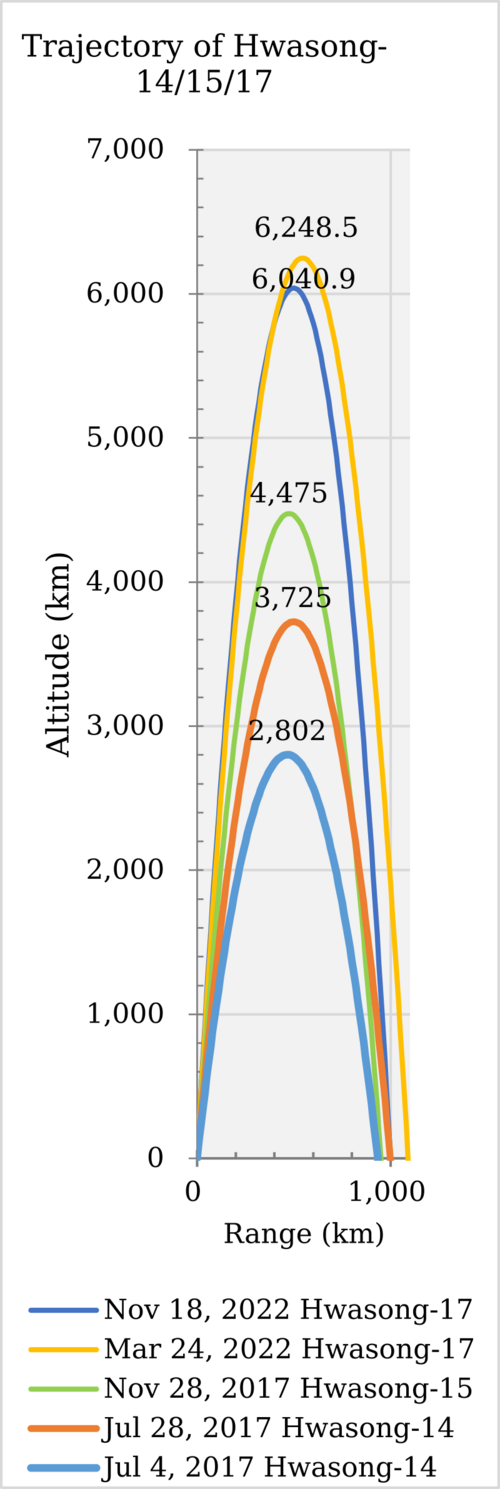You are using an out of date browser. It may not display this or other websites correctly.
You should upgrade or use an alternative browser.
You should upgrade or use an alternative browser.
Current US hypersonic weapons projects. (General)
- Thread starter Hanse
- Start date
I believe this is the right thread for this Defense Updates video concerning the USAF's current and future strike and interceptor missiles:
The war in Ukraine, the withdrawal from INF Treaty due to Russian non-compliance, Iran & North Korea’s significant military buildup as well as Chinese aggression in the South China Sea has pushed the U.S. military to come to terms with new realities.Gone are the days when it was waging wars against adversaries with no-to-limited high-tech weaponry.The US military is taking key steps to evolve and one crucial aspect of this endeavor is adding new cutting-edge missiles to its inventory.
In this video, Defense Updates analyzes what new missiles the U.S. military will bring to the fight in the coming days?
Forest Green
ACCESS: Above Top Secret
- Joined
- 11 June 2019
- Messages
- 9,365
- Reaction score
- 17,050
This missile just gets longer and longer and longer ranged!
View: https://x.com/AirPowerNEW1/status/1815914998289555646

Guam (left), Ramstein (right)


View: https://x.com/AirPowerNEW1/status/1815914998289555646

Guam (left), Ramstein (right)


Last edited:
kqcke for you
PUMA PUMA PUMA
- Joined
- 3 November 2022
- Messages
- 1,269
- Reaction score
- 1,660
Did Lrwh have a warhead or was it full kinematics?This missile just gets longer and longer and longer ranged!
View: https://x.com/AirPowerNEW1/status/1815914998289555646
View attachment 735286
Guam (left), Rammstein (right)
View attachment 735287View attachment 735288
- Joined
- 2 March 2006
- Messages
- 329
- Reaction score
- 236
OT (sorry) ... but *LOL*!!Guam (left), Rammstein (right)


The US base in Germany is named Ramstein. Rammstein is the well-known hard rock band. They are famous for the extensive use of pyrotechnics in their shows, but I think a full-scale LRHW launch would be a bit over the top
Forest Green
ACCESS: Above Top Secret
- Joined
- 11 June 2019
- Messages
- 9,365
- Reaction score
- 17,050
I have 4 albums, I assumed the spelling was the same for some reason.OT (sorry) ... but *LOL*!!
The US base in Germany is named Ramstein. Rammstein is the well-known hard rock band. They are famous for the extensive use of pyrotechnics in their shows, but I think a full-scale LRHW launch would be a bit over the top.
Usually tested with an inert warhead, my guess.Did Lrwh have a warhead or was it full kinematics?
I would assume so, but we will find out.Is the army test going to use the real launcher or just a test stand?
bring_it_on
I really should change my personal text
- Joined
- 4 July 2013
- Messages
- 3,636
- Reaction score
- 3,739
The test event will most likely involve the LRHW launcher and battery.Is the army test going to use the real launcher or just a test stand?
Alex Hollings from Sandboxx has just put out a video concerning LM's Mako:
-- BREAK --
Lockheed Martin has released new details about the air-launched hypersonic Mako missile, which promises to be the first hypersonic weapon in the world that can be launched from the internal weapons bay of not just the F-35, but the F-22 Raptor as well.
This new missile has been under development for seven years and has been touted by Lockheed officials as a “multi-mission” weapon system capable of maritime strike, counter-air defense, and a variety of other surface-attack operations. It was originally developed for the U.S. Air Force, but now may find a home with the U.S. Navy instead.
Let's talk about what we've learned about this groundbreaking new weapon.
You can catch our first deep dive into the Mako Missile here:• The new HYPERSONIC missile that fits ...
And you can read our full coverage of this development on Sandboxx News here: https://www.sandboxx.us/news/lockheed...
Scott Kenny
ACCESS: USAP
- Joined
- 15 May 2023
- Messages
- 11,258
- Reaction score
- 13,694
As if Rammstein wouldn't accept a request to perform at the launch of an LRHW...OT (sorry) ... but *LOL*!!
The US base in Germany is named Ramstein. Rammstein is the well-known hard rock band. They are famous for the extensive use of pyrotechnics in their shows, but I think a full-scale LRHW launch would be a bit over the top.
- Joined
- 4 July 2010
- Messages
- 2,509
- Reaction score
- 3,073
Forest Green
ACCESS: Above Top Secret
- Joined
- 11 June 2019
- Messages
- 9,365
- Reaction score
- 17,050
I wonder if the plan is to have it re-enter at the start of the marked area and then pull up and manoeuvre the rest of the way. Looks like they might be firing two. Anyone notice that there is another 'red' area marked higher up and the central red area appears to diverge, with the top part being in line with the upper read zone later on. Is this where the booster will fall? Is the C-HGB also going to perform an exo-atmospheric diversion manoeuvre? 


Last edited:
Stage drop offs?
The first red trapezoid looks configured to allow a stage separation for either of furthest impact zones. If that’s the case, it’s worth noting this AUP has a huge minimum range. Not surprising, but worth measuring.
Forest Green
ACCESS: Above Top Secret
- Joined
- 11 June 2019
- Messages
- 9,365
- Reaction score
- 17,050
It looks like two missiles are being fired to me but the divert area does not line up with the launch point for the upper one, so there must be a divert in space. It's fairly confusing either way TBH.It looks CB like there is a divert area, or else more than one shot. What is the significance of the purple line vice the red line to the reentry point? 3400 km vice 4450?
I think the purple line is just measuring to the start of the re-entry area and the red to the end. Whether this implies the C-HGB re-enters at the start and manoeuvres to the end in atmosphere or not I don't know. It could be.
I don't think you can say much about minimum range form where the stages land. That's just where they land on that launch trajectory.
It looks like two missiles are being fired to me but the divert area does not line up with the launch point for the upper one, so there must be a divert in space. It's fairly confusing either way TBH.
I think the purple line is just measuring to the start of the re-entry area and the red to the end. Whether this implies the C-HGB re-enters at the start and manoeuvres to the end in atmosphere or not I don't know. It could be.
I don't think you can say much about minimum range form where the stages land. That's just where they land on that launch trajectory.
The trapezoid area starts almost a thousand miles off the Cape.
Do we know anything about the trajectory/altitude? Does the system truly enter space in the technical sense (100km)? Is there a reentry similar to a medium/intermediate ballistic missile?
Also if 4450km/2700mi is the splashdown, then the previous “1750mi” range given by the army was clearly politically motivated.
Actually thinking about it more - if the trajectory is truly ballistic, with the glider reentering and then maneuvering, then it should be coming down roughly in the same area as the booster until it catches enough atmosphere to pull up. That *would* mean that the minimum range was not much shorter than the booster splash down.
Alternatively, I thought that test they did with the Atlas missile in the 60s actually went horizontal rather quickly and was largely endoatmospheric. I do not know enough about aerodynamics or rocketry to understand the LRHW's trajectory. If it were flatter, I assume that would mean a second stage with a long sustainer grained motor. If it is ballistic, then I assume hard burn all the way and that the RV falls into enough atmosphere to maneuver not to far in front of the spent stage. I am not knowledgeable enough to know what kind of trajectory it has though.
Alternatively, I thought that test they did with the Atlas missile in the 60s actually went horizontal rather quickly and was largely endoatmospheric. I do not know enough about aerodynamics or rocketry to understand the LRHW's trajectory. If it were flatter, I assume that would mean a second stage with a long sustainer grained motor. If it is ballistic, then I assume hard burn all the way and that the RV falls into enough atmosphere to maneuver not to far in front of the spent stage. I am not knowledgeable enough to know what kind of trajectory it has though.
Forest Green
ACCESS: Above Top Secret
- Joined
- 11 June 2019
- Messages
- 9,365
- Reaction score
- 17,050
It would have to enter space to achieve anything like that range.The trapezoid area starts almost a thousand miles off the Cape.
Do we know anything about the trajectory/altitude? Does the system truly enter space in the technical sense (100km)? Is there a reentry similar to a medium/intermediate ballistic missile?
Scott Kenny
ACCESS: USAP
- Joined
- 15 May 2023
- Messages
- 11,258
- Reaction score
- 13,694
I would not discount the ability to stay in the atmosphere like that Atlas HGV did as a targeting option.It would have to enter space to achieve anything like that range.
Forest Green
ACCESS: Above Top Secret
- Joined
- 11 June 2019
- Messages
- 9,365
- Reaction score
- 17,050
Atlas is huge by comparison.
I’d think more along the lines of glide body reentry on the first shape and terminal maneuver for the second. It is not a ballistic trajectory.The first red trapezoid looks configured to allow a stage separation for either of furthest impact zones. If that’s the case, it’s worth noting this AUP has a huge minimum range. Not surprising, but worth measuring.
I’d think more along the lines of glide body reentry on the first shape and terminal maneuver for the second. It is not a ballistic trajectory.
Fair enough, but would not glide body reentry if anything even more accurately indicate minimum range?
Scott Kenny
ACCESS: USAP
- Joined
- 15 May 2023
- Messages
- 11,258
- Reaction score
- 13,694
For the exoatmospheric flight paths, yes.Fair enough, but would not glide body reentry if anything even more accurately indicate minimum range?
I'm not willing to accept that there isn't an alternative where the upper stage goes parallel to the ground like that Atlas HGV test in the 60s.
I'm not willing to accept that there isn't an alternative where the upper stage goes parallel to the ground like that Atlas HGV test in the 60s.
Didn't the Atlas boosters reach an altitude of about 30-40 miles (After shutdown and separation of the booster engines) before they pitched over?
Forest Green
ACCESS: Above Top Secret
- Joined
- 11 June 2019
- Messages
- 9,365
- Reaction score
- 17,050
Didn't the Atlas boosters reach an altitude of about 30-40 miles (After shutdown and separation of the booster engines) before they pitched over?

February 26, 1968
"A typical BGRV flight trajectory and footprint is illustrated in Figure 12. In profile, the Atlas missile would fly to an altitude of about 130,000 feet, turn to horizontal flight to gain speed, and then would separate BGRV on a glide-path at over Mach 15 toward 110,000 foot altitude. The vehicle would spin up, establish a lifting angle of attack to offset gravity, and glide with little change in attitude, managing its energy to reach the desired destination. In the target area, programmed steering equations would take over and turn the vehicle into a terminal dive and maneuver to the intended aimpoint.
Because of its enormous kinetic energy and high L/D, BGRV could glide downrange nearly 5,000 miles or turn out of plane cross range about 2,000 miles. At altitudes near 100,000 feet, there was so little atmosphere; turns took long distances to accomplish and resulted in higher loss of energy than forward fight. The entire flight to maximum range was almost 45 minutes, about twice as long as ballistic missile transit."
In profile, the Atlas missile would fly to an altitude of about 130,000 feet, turn to horizontal flight to gain speed, and then would separate BGRV on a glide-path at over Mach 15 toward 110,000 foot altitude.
I don't know what altitude an Atlas would normally shutdown its' booster engines but at 130,000Ft (~25 miles) that would have to be right after it shut down and jettisoned the booster-engines or shut them down early. Anyway 130,000Ft for a rocket like that is a very low altitude, the aero thermal loads must've been significant.
Forest Green
ACCESS: Above Top Secret
- Joined
- 11 June 2019
- Messages
- 9,365
- Reaction score
- 17,050
It flies horizontally on boost to gain speed.I don't know what altitude an Atlas would normally shutdown its' booster engines but at 130,000Ft (~25 miles) that would have to be right after it shut down and jettisoned the booster-engines or shut them down early. Anyway 130,000Ft for a rocket like that is a very low altitude, the aero thermal loads must've been significant.
It flies horizontally on boost to gain speed.
It wouldn't have needed the boosters once it got that high due to a significant proportion of its LOX/RP-1 propellant would've been burned and the Atlas D (I assume it was an Atlas D) had a sustainer rocket-motor thrust of ~81,000Lb. No doubt the booster-section would've been shutdown and jettisoned to avoid over-speeding.
- Joined
- 3 June 2011
- Messages
- 18,293
- Reaction score
- 12,095
fly to an altitude of about 130,000 feet, turn to horizontal flight to gain speed, and then would separate BGRV on a glide-path at over Mach 15 toward 110,000 foot altitudeIt wouldn't have needed the boosters once it got that high due to a significant proportion of its LOX/RP-1 propellant would've been burned and the Atlas D (I assume it was an Atlas D) had a sustainer rocket-motor thrust of ~81,000Lb. No doubt the booster-section would've been shutdown and jettisoned to avoid over-speeding.
If Mach 15 was the designed release speed, maybe they just fired the release mechanism, shut down the engines, and let drag separate them.
Whether the flight path is flat or ballistic, it seems likely to me the first red zone of the NOTAM is booster splash down and that this represents either burn out and separation of the glider or reentry of the spent booster and glider. Either way, it is probably a minimum range of the system. There may be further limitations on the glider when it is operating at its maximum speed and thermal load. If this estimate of minimum range (~1000mi/1500km) were accurate, that has a lot of consequences for basing - for instance basing in Southern Japan or Northern PI would actually put a huge number of likely desired targets far too close.
kqcke for you
PUMA PUMA PUMA
- Joined
- 3 November 2022
- Messages
- 1,269
- Reaction score
- 1,660
Tought maybe Opfires could solve that problem to some extend with that development in an future Version of it.Whether the flight path is flat or ballistic, it seems likely to me the first red zone of the NOTAM is booster splash down and that this represents either burn out and separation of the glider or reentry of the spent booster and glider. Either way, it is probably a minimum range of the system. There may be further limitations on the glider when it is operating at its maximum speed and thermal load. If this estimate of minimum range (~1000mi/1500km) were accurate, that has a lot of consequences for basing - for instance basing in Southern Japan or Northern PI would actually put a huge number of likely desired targets far too close.
kqcke for you
PUMA PUMA PUMA
- Joined
- 3 November 2022
- Messages
- 1,269
- Reaction score
- 1,660
Thanks. Does it have an warhead for life rounds ?Usually tested with an inert warhead, my guess.
Edit: i remember that it was talked about in some thread but i can't find it anymore.
Thanks. Does it have an warhead for life rounds ?
Edit: i remember that it was talked about in some thread but i can't find it anymore.
I don’t think we know, but I would assume at least some kind of bursting charge and proxy fusing for soft targets.
Forest Green
ACCESS: Above Top Secret
- Joined
- 11 June 2019
- Messages
- 9,365
- Reaction score
- 17,050
Highly likely.Thanks. Does it have an warhead for life rounds ?
Don't see where that logic is coming from. You could fire it on a trajectory with a higher apogee;Whether the flight path is flat or ballistic, it seems likely to me the first red zone of the NOTAM is booster splash down and that this represents either burn out and separation of the glider or reentry of the spent booster and glider.

Or given that it's a MaRV, use a depressed trajectory. Where the booster lands on this test only indicates where the booster lands when fired to this range. I mean even a Trident D-5 can be fired on an 1,850km trajectory.
If the second stage leaves the atmosphere during burn it will probably re-enter where the C-HGB does, since there is no drag in space and it's moving at the same speed. However, it will likely burn up on re-entry as it's not designed for that, hence no need for NOTAM.LRHW is two stage, correct? Where is the NOTAM for the first stage? It must separate in a matter of se ones after launch.
Last edited:
Highly likely.
Don't see where that logic is coming from. You could fire it on a trajectory with a higher apogee;
View attachment 735509
Or given that it's a MaRV, use a depressed trajectory. Where the booster lands on this test only indicates where the booster lands when fired to this range. I mean even a Trident D-5 can be fired on an 1,850km trajectory.
If the second stage leaves the atmosphere during burn it will probably re-enter where the C-HGB does, since there is no drag in space and it's moving at the same speed. However, it will likely burn up on re-entry as it's not designed for that, hence no need for NOTAM.
Fair enough.
Scott Kenny
ACCESS: USAP
- Joined
- 15 May 2023
- Messages
- 11,258
- Reaction score
- 13,694
Which is why it has an all in-atmosphere range of 5000 miles/8000km.Atlas is huge by comparison.
I'm using that flight profile to try to minimize or eliminate the minimum range.
Similar threads
-
Lockheed Martin AGM-183 Air-Launched Rapid Response Weapon (ARRW)
- Started by Moose
- Replies: 667
-
-
China DF-17 hypersonic boost-glide missile carrier
- Started by antigravite
- Replies: 41
-
-
